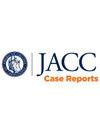Infective Endocarditis 19 Months After Transcatheter Ostium Secundum Atrial Septal Defect Closure in a 6-Year-Old
Q4 Medicine
引用次数: 0
Abstract
Background
Infective endocarditis (IE) after transcatheter atrial septal defect (ASD) closure is rare.
Case Summary
We report the case of a 6-year-old girl who developed methicillin-resistant Staphylococcus aureus IE 19 months after ASD closure with an Amplatzer device. She presented with severe sepsis, a large vegetation on the right atrial side of the occluder, and moderate tricuspid regurgitation. Despite empirical antibiotic therapy, persistent bacteremia mandated surgical removal of the device, ASD closure with a pericardial patch, and tricuspid valve repair. Six weeks of targeted antibiotics led to a favorable 1-year outcome.
Discussion
This case, alongside other reports of late-onset IE after transcatheter ASD closure, highlights that although rare, such infections can occur well beyond 6 months postprocedure. This observation questions current guidelines restricting prophylactic measures to the early postimplant period.
Take-Home Message
Patients with septal occluders may require prolonged vigilance and reinforced education on skin and dental hygiene to minimize the risk of late IE.
1例6岁儿童经导管第二口房间隔缺损闭合后19个月的感染性心内膜炎
背景经导管房间隔缺损(ASD)闭合后发生有效的心内膜炎(IE)是罕见的。我们报告了一例6岁女孩在使用Amplatzer装置闭合ASD 19个月后出现耐甲氧西林金黄色葡萄球菌IE的病例。她表现为严重的脓毒症,闭塞器右心房有很大的植被,中度三尖瓣反流。尽管经经验的抗生素治疗,持续菌血症要求手术切除装置,用心包贴片闭合ASD,并修复三尖瓣。6周的靶向抗生素治疗导致1年的良好结果。本病例与其他经导管ASD闭合后迟发性IE的报道一起强调,尽管罕见,但此类感染可能发生在手术后6个月以上。这一观察结果对目前将预防措施限制在移植后早期的指导方针提出了质疑。有鼻中隔闭塞的患者可能需要长期保持警惕,加强皮肤和牙齿卫生教育,以尽量减少晚期IE的风险。
本文章由计算机程序翻译,如有差异,请以英文原文为准。
求助全文
约1分钟内获得全文
求助全文
来源期刊

JACC. Case reports
Medicine-Cardiology and Cardiovascular Medicine
CiteScore
1.30
自引率
0.00%
发文量
404
审稿时长
17 weeks
 求助内容:
求助内容: 应助结果提醒方式:
应助结果提醒方式:


